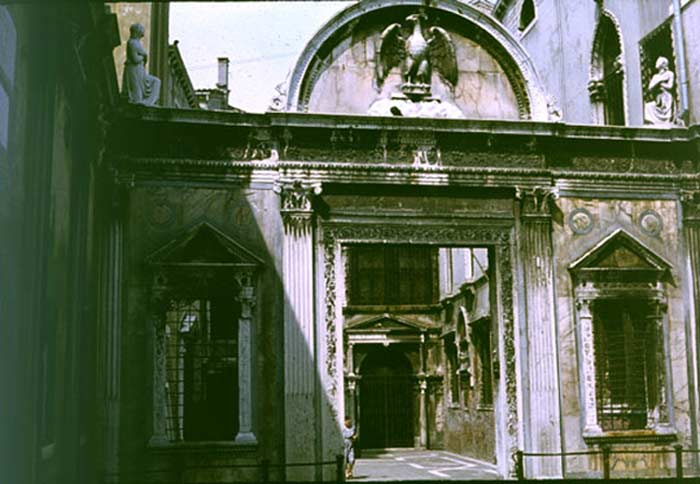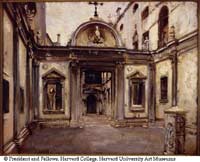Scuola Grande di San
Giovanni Evangelista
Jpg: socrates.berkeley.edu
Scuola meaning school
From: Philip Resheph
Date: October, 2000
Located just north of the
Frari in E4
From Timeout.com:
The Scuola di San Giovanni
Evangelista is one of the six Scuole Grandi that played an important
part in the complex Venetian system of social checks and balances.
San Giovanni Evangelista
started in a building that had formerly been a home for the elderly.
As a result, the building is L-shaped. The courtyard is protected
by a screen with a magnificent eagle pediment and a frieze of leaf-sprays
by Pietro Lombardo, while the building itself contains a double-staircase
by Coducci.
(timeout.com)
From Joann Zimmerman:
Scuole were religious confraternities.
They existed for the purposes of religious self-improvement, charitable
deeds, and general fellowship. Scuole grandi were large all-male confraternities
whose memberships were drawn from the upper and middle classes across
the entire city. [There were other Scuole, but the grandi were just male.]
There were six of these by the end of the sixteenth century, and
a seventh was added in the seventeenth century. The original four
(San Marco, San Giovanni Evangelista, Carita, and Misericordia)
All the scuole . . . had meeting
places. Sometimes these were churches, but more often . . .
there were separate buildings, which would frequently be adjacent
to a church, monastery or convent.
(Joann
Zimmerman)
From Timeout.com:
Contained in a tight grouping is
three building: Frari (with its 70-metre high campanile), the Renaissance
magnificence Scuola of San Rocco, and this scuola of San Giovanni Evangelista.
These buildings contain perhaps the greatest concentration of innovative
and influential works of art in the city outside Piazza San Marco.
And it ain't just art: the monastery
buildings of the Frari now contain the State Archives, a monument to the
Venetian reluctance ever to throw anything away. In 300 rooms, about 15
million volumes and files are conserved, relating to all aspects of Venetian
history, starting from the year 883. It is said that only the Spanish archives
at Simancas approach them in scope and detail. Faced with this daunting
wealth of information, ranging from ambassadors' dispatches on foreign
courts to spies' reports on noblemen's non-regulation cloaks, grown historians
have been reduced to quivering wrecks.
North of here runs Rio Marin, a canal
with fondamente on both sides, lined by some fine buildings; these include
the late-sixteenth century Palazzo Soranzo Capello, with a small garden
(to the rear) that figures in D'Annunzio's torrid novel "ll Fuoco" and
Henry James's more restrained "The Aspern Papers", and the seventeenth-century
Palazzo Gradenigo, whose garden was once large enough to host bullfights.
(timeout.com)
Notes:
|



